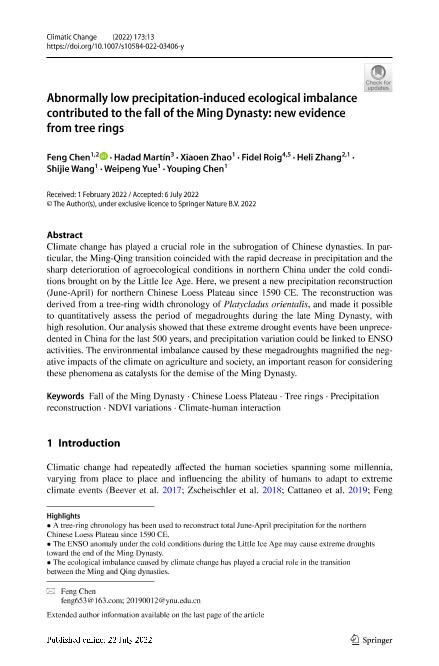Artículo
Abnormally low precipitation-induced ecological imbalance contributed to the fall of the Ming Dynasty: new evidence from tree rings
Chen, Feng; Hadad, Martín Ariel ; Zhao, Xiaoen; Roig Junent, Fidel Alejandro
; Zhao, Xiaoen; Roig Junent, Fidel Alejandro ; Zhang, Heli; Wang, Shijie; Yue, Weipeng; Chen, Youping
; Zhang, Heli; Wang, Shijie; Yue, Weipeng; Chen, Youping
 ; Zhao, Xiaoen; Roig Junent, Fidel Alejandro
; Zhao, Xiaoen; Roig Junent, Fidel Alejandro ; Zhang, Heli; Wang, Shijie; Yue, Weipeng; Chen, Youping
; Zhang, Heli; Wang, Shijie; Yue, Weipeng; Chen, Youping
Fecha de publicación:
07/2022
Editorial:
Springer
Revista:
Climatic Change
ISSN:
0165-0009
Idioma:
Inglés
Tipo de recurso:
Artículo publicado
Clasificación temática:
Resumen
Climate change has played a crucial role in the subrogation of Chinese dynasties. In particular, the Ming-Qing transition coincided with the rapid decrease in precipitation and the sharp deterioration of agroecological conditions in northern China under the cold conditions brought on by the Little Ice Age. Here, we present a new precipitation reconstruction (June-April) for northern Chinese Loess Plateau since 1590 CE. The reconstruction was derived from a tree-ring width chronology of Platycladus orientalis, and made it possible to quantitatively assess the period of megadroughts during the late Ming Dynasty, with high resolution. Our analysis showed that these extreme drought events have been unprecedented in China for the last 500 years, and precipitation variation could be linked to ENSO activities. The environmental imbalance caused by these megadroughts magnified the negative impacts of the climate on agriculture and society, an important reason for considering these phenomena as catalysts for the demise of the Ming Dynasty.
Archivos asociados
Licencia
Identificadores
Colecciones
Articulos(CIGEOBIO)
Articulos de CENTRO DE INVESTIGACIONES DE LA GEOSFERA Y BIOSFERA
Articulos de CENTRO DE INVESTIGACIONES DE LA GEOSFERA Y BIOSFERA
Articulos(IANIGLA)
Articulos de INST. ARG. DE NIVOLOGIA, GLACIOLOGIA Y CS. AMBIENT
Articulos de INST. ARG. DE NIVOLOGIA, GLACIOLOGIA Y CS. AMBIENT
Citación
Chen, Feng; Hadad, Martín Ariel; Zhao, Xiaoen; Roig Junent, Fidel Alejandro; Zhang, Heli; et al.; Abnormally low precipitation-induced ecological imbalance contributed to the fall of the Ming Dynasty: new evidence from tree rings; Springer; Climatic Change; 173; 1-2; 7-2022; 1-16
Compartir
Altmétricas



